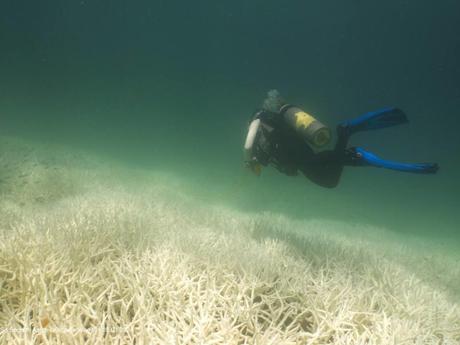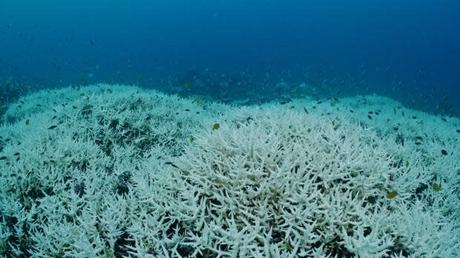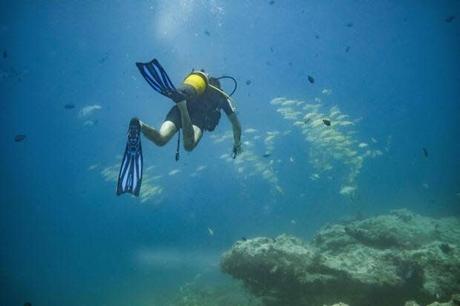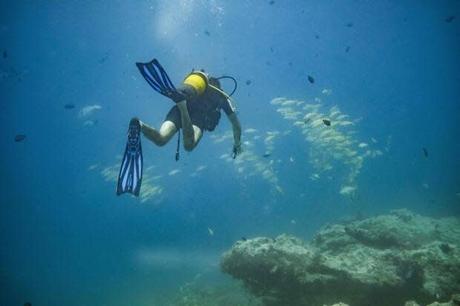
The world's oceans are experiencing another global mass coral bleaching event due to unprecedented heat, scientists from the US National Oceanic and Atmospheric Administration confirmed.
"This is the fourth time coral bleaching has occurred simultaneously in all major ocean basins," said Derek Manzello, ecologist and coordinator of NOAA's Coral Reef Watch.
Bleaching - a ghostly discoloration, in stark contrast to the vibrant colors found in reefs - can occur when corals undergo heat stress, expelling microscopic algae from within. The longer and hotter it gets, the more likely the corals will die, disrupting fragile ecosystems as well as the lives and livelihoods of people who depend on them.
But the full extent of the damage is yet to come. Manzello sees an increase in the number of affected reefs every week.
"If this trend continues, this will be the most spatially extensive global bleaching event ever recorded - potentially within just a few weeks," Manzello warned.


Global sea surface temperatures have reached new highs in the past year, driven in part by oceans absorbing excess atmospheric carbon from greenhouse gas emissions.
NOAA has confirmed mass bleaching in reefs around the world, from Panama to the Persian Gulf to the South Pacific. Manzello says just over half of the world's reefs were affected by the current event, but in the Atlantic Ocean this was almost entirely the case, with a record 98.5 percent of coral zones there experiencing bleach-level heat.
Just last week, the Australian Marine Conservation Society sounded the alarm about bleaching in the southern Great Barrier Reef, where the latest global bleaching event ultimately killed a third of all corals.
Coral Reef Watch satellite data shows that hotspots are observed in every ocean, with corals in the Atlantic, Pacific and Indian Oceans experiencing a range of moderate to extreme heat stress. In fact, unprecedented ocean temperatures last year forced a review of this warning system - adding levels 3 through 5, the latter of which represents "the risk of near-complete mortality."
The story continues
Stressed outRohan Arthur, a marine biologist who has extensively studied the reefs in Lakshadweep off the southwestern coast of India, expected this explanation.
But as he darkly put it, "with all the enthusiasm of an undertaker measuring a corpse."
Arthur, who works at the Nature Conservation Foundation in Mysuru, India, has been monitoring sea surface temperatures in Lakshadweep over the past year and has seen an unprecedented increase of 1 degree Celsius above average. The corals are starting to show it too.
"A mass bleaching event in itself is a morbidly beautiful sight," Arthur wrote to CBC News via email, "with the reef turning every shade of pink, blue and white on its way to a surreal death."
After more than 25 years of watching those reefs, including previous bleaching events, Arthur feels the impending devastation in the pit of his stomach. It's a connection echoed an ocean away by Nicola Smith, an assistant professor of biology at Concordia University in Montreal.
"It affects me personally when I think about this damage," said Smith, who was born and raised in the Bahamas. When these heat waves hit at sea, there is little escape.
"It feels like you're swimming in a cup of tea," Smith said. Marine organisms "remain in these high temperatures for very long periods of time and become physiologically stressed."


That stress also affects the life around the corals, including the fish that eat the expelled algae. But experts emphasize that bleaching does not mean death.
"Recovery can happen," says Xinru Li, a postdoctoral researcher at Princeton University in New Jersey. As temperatures stabilize, corals can bounce back. She notes that hardiness varies by species and location, with some being more tolerant of heat. Smith adds that corals that survive bleaching may develop genes that make them resistant in the future.
"But if bleaching occurs more frequently, there will simply be no energy and no time for corals to recover," Li explained, noting that amid ongoing climate change, marine heat waves will be more frequent and intense, effectively killing corals " killing window" for corals. rejuvenate.
Food, shelter and shieldBecause they are both organism and habitat - for an estimated 25 percent of the world's marine life - experts say corals are crucial to the communities around them.
"If a coral reef dies, the coral fish will leave the habitat because they cannot survive there," Li explains. She points to centrally located Kiribati in the Pacific Ocean, where fishermen depend on reef fish populations for their livelihoods.
Smith says both recreational tourism and food security have suffered, including access to affordable protein sources found in reef fish. Furthermore, as climate change warms the ocean and erodes these reefs, a line of defense is lost.
"Corals form a natural sea wall," says Smith, describing them as "a kind of barrier against the big waves that come with intense storms" driven by climate change.
Will there be relief?Another contributor to mass bleaching is the naturally occurring phenomenon of El Niño, which was also present during the last three events in 1998, 2010 and 2014-2017. Characterized by warming waters in the Pacific Ocean, it can also drive up global temperatures and influence weather patterns as well.
The potential good news is that the current El Niño is waning, with NOAA's Climate Prediction Center expecting a period of neutrality between April and June - with the cooler La Niña pattern "possibly developing in late summer 2024 ."
LOOK | Florida's coral reefs are hurting, but this could be the way to save them:The wrinkle, however, is that both climate patterns - known as the El Niño-Southern Oscillation - have become warmer. Manzello points out that local coral bleaching events have also occurred during the normally cool La Niña years. Still, he hopes it can provide some relief to parts of the Pacific where the situation is dire.
"La Niña can't come soon enough," Manzello said.
But Smith warns that, given the Intergovernmental Panel on Climate Change's assessment that future warming of 2 degrees Celsius could lead to the loss of 99 percent of the world's coral, hoping for a cooler period is short-term thinking, compared to more do to reduce our emissions. to control warming.
"It's quite frustrating because our lack of action on climate change will literally lead to mass extinction."
